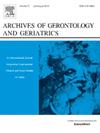亚洲恶病质工作组2023标准将恶病质定义为脑卒中后患者功能恢复的决定因素
IF 3.8
3区 医学
Q2 GERIATRICS & GERONTOLOGY
引用次数: 0
摘要
背景和目的恶病质是脑卒中患者的常见疾病,但根据亚洲恶病质工作组(AWGC) 2023标准,其患病率和对功能结局的影响尚不清楚。本研究旨在确定恶病质的患病率,并检查其与功能预后的关系急性脑卒中后患者能够口服。方法回顾性队列研究纳入856例脑卒中后患者(平均(SD)年龄:78(7)岁;2015年至2023年期间,日本一家康复医院收治了52%的男性。在入院时使用AWGC 2023标准诊断恶病质。使用功能独立性测量(FIM)-放电时运动评分和FIM-运动增益来评估功能结果。使用多元线性回归分析恶病质与功能结局之间的关系,调整年龄、性别、卒中类型、基线fim -运动和fim -认知评分以及其他混杂因素。结果20%(172/856)的患者被诊断为脓毒症。平均住院时间(SD)为85(44)天。脑梗死(n = 634, 74%)、脑出血(n = 188, 22%)、蛛网膜下腔出血(n = 34,4%)为脑卒中类型。最常见的基础疾病是癌症(n = 120,14 %)、慢性心力衰竭(n = 52,6 %)和慢性肾脏疾病(n = 26,3 %)。在调整混杂因素后,恶病质仍然与放电时较低的FIM-motor (β=-0.092, P = 0.009)和较低的FIM-motor增益(β=-0.079, P = 0.024)独立相关。结论AWGC 2023标准定义的恶病质在脑卒中后患者中普遍存在,并对功能恢复产生负面影响。早期识别和有针对性的干预可能对改善康复结果和生活质量至关重要。本文章由计算机程序翻译,如有差异,请以英文原文为准。

Cachexia defined by the Asian Working Group for Cachexia 2023 criteria as a determinant of functional recovery in post-stroke patients capable of oral intake
Background and aims
Cachexia is a common condition in stroke patients, yet its prevalence and impact on functional outcomes based on the Asian Working Group for Cachexia (AWGC) 2023 criteria remain unclear. This study aimed to determine the prevalence of cachexia and examine its association with functional prognosis in post-acute stroke patients capable of oral intake.
Methods
This retrospective cohort study included 856 post-stroke patients (mean (SD) age: 78 (7) years; 52 % men) admitted to a Japanese rehabilitation hospital between 2015 and 2023. Cachexia was diagnosed at admission using the AWGC 2023 criteria. Functional outcomes were assessed using the Functional Independence Measure (FIM)-motor score at discharge and FIM-motor gain. The association between cachexia and functional outcomes was analyzed using multiple linear regression, adjusting for age, sex, stroke type, baseline FIM-motor and FIM-cognitive scores, and other confounders.
Results
Cachexia was diagnosed in 20 % (172/856) of patients. The mean (SD) length of hospital stay was 85 (44) days. Stroke types were cerebral infarction (n = 634, 74 %), cerebral hemorrhage (n = 188, 22 %), and subarachnoid hemorrhage (n = 34, 4 %). The most common underlying diseases were cancer (n = 120, 14 %), chronic heart failure (n = 52, 6 %), and chronic kidney disease (n = 26, 3 %). After adjusting for confounders, cachexia remained independently associated with lower FIM-motor at discharge (β=-0.092, P = 0.009) and lower FIM-motor gain (β=-0.079, P = 0.024).
Conclusion
Cachexia, as defined by the AWGC 2023 criteria, was prevalent in post-stroke patients and negatively impacted functional recovery. Early identification and targeted interventions may be essential for improving rehabilitation outcomes and quality of life.
求助全文
通过发布文献求助,成功后即可免费获取论文全文。
去求助
来源期刊
CiteScore
7.30
自引率
5.00%
发文量
198
审稿时长
16 days
期刊介绍:
Archives of Gerontology and Geriatrics provides a medium for the publication of papers from the fields of experimental gerontology and clinical and social geriatrics. The principal aim of the journal is to facilitate the exchange of information between specialists in these three fields of gerontological research. Experimental papers dealing with the basic mechanisms of aging at molecular, cellular, tissue or organ levels will be published.
Clinical papers will be accepted if they provide sufficiently new information or are of fundamental importance for the knowledge of human aging. Purely descriptive clinical papers will be accepted only if the results permit further interpretation. Papers dealing with anti-aging pharmacological preparations in humans are welcome. Papers on the social aspects of geriatrics will be accepted if they are of general interest regarding the epidemiology of aging and the efficiency and working methods of the social organizations for the health care of the elderly.

 求助内容:
求助内容: 应助结果提醒方式:
应助结果提醒方式:


